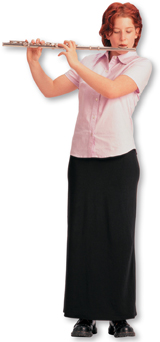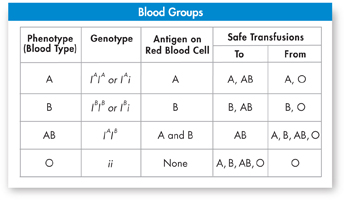Transmission of Human Traits
 What patterns of inheritance do human traits follow?
What patterns of inheritance do human traits follow?
It has not been easy studying our species using traditional genetic techniques. Despite the difficulties, human genetics has progressed rapidly, especially in recent years, with the use of molecular techniques to study human DNA. What have these studies shown? Human genes follow the same Mendelian patterns of inheritance as the genes of other organisms.
Dominant and Recessive Alleles  Many human traits follow a pattern of simple dominance. For instance, a gene known as MC1R helps determine skin and hair color. Some of MC1R's recessive alleles produce red hair. An individual with red hair usually has two of these recessive alleles, inheriting a copy from each parent. Dominant alleles for the MC1R gene help produce darker hair colors.
Many human traits follow a pattern of simple dominance. For instance, a gene known as MC1R helps determine skin and hair color. Some of MC1R's recessive alleles produce red hair. An individual with red hair usually has two of these recessive alleles, inheriting a copy from each parent. Dominant alleles for the MC1R gene help produce darker hair colors.
Another trait that displays simple dominance is the Rhesus, or Rh blood group. The allele for Rh factor comes in two forms: Rh+ and Rh−. Rh+ is dominant, so an individual with both alleles (Rh+/Rh−) is said to have Rh positive blood. Rh negative blood is found in individuals with two recessive alleles (Rh−/Rh−).
Codominant and Multiple Alleles  The alleles for many human genes display codominant inheritance. One example is the ABO blood group, determined by a gene with three alleles: IA, IB, and i. Alleles IA and IB are codominant. They produce molecules known as antigens on the surface of red blood cells. As Figure 14–5 shows, individuals with alleles IA and IB produce both A and B antigens, making them blood type AB. The i allele is recessive. Individuals with alleles IAIA or IAi produce only the A antigen, making them blood type A. Those with IBIB or IBi alleles are type B. Those homozygous for the i allele (ii) produce no antigen and are said to have blood type O. If a patient has AB-negative blood, it means the individual has IA and IB alleles from the ABO gene and two Rh− alleles from the Rh gene.
The alleles for many human genes display codominant inheritance. One example is the ABO blood group, determined by a gene with three alleles: IA, IB, and i. Alleles IA and IB are codominant. They produce molecules known as antigens on the surface of red blood cells. As Figure 14–5 shows, individuals with alleles IA and IB produce both A and B antigens, making them blood type AB. The i allele is recessive. Individuals with alleles IAIA or IAi produce only the A antigen, making them blood type A. Those with IBIB or IBi alleles are type B. Those homozygous for the i allele (ii) produce no antigen and are said to have blood type O. If a patient has AB-negative blood, it means the individual has IA and IB alleles from the ABO gene and two Rh− alleles from the Rh gene.

FIGURE 14–4 Recessive Alleles Some of the recessive alleles of the MC1R gene cause red hair. An individual with red hair usually has two of these recessive alleles.

FIGURE 14–5 Human Blood Groups This table shows the relationship between genotype and phenotype for the ABO blood group. It also shows which blood types can safely be transfused into people with other blood types. Apply Concepts How can there be four different phenotypes even though there are six different genotypes?
dddTable of Contents
- Formulas and Equations
- Applying Formulas and Equations
- Mean, Median, and Mode
- Estimation
- Using Measurements in Calculations
- Effects of Measurement Errors
- Accuracy
- Precision
- Comparing Accuracy and Precision
- Significant Figures
- Calculating With Significant Figures
- Scientific Notation
- Calculating With Scientific Notation
- Dimensional Analysis
- Applying Dimensional Analysis




